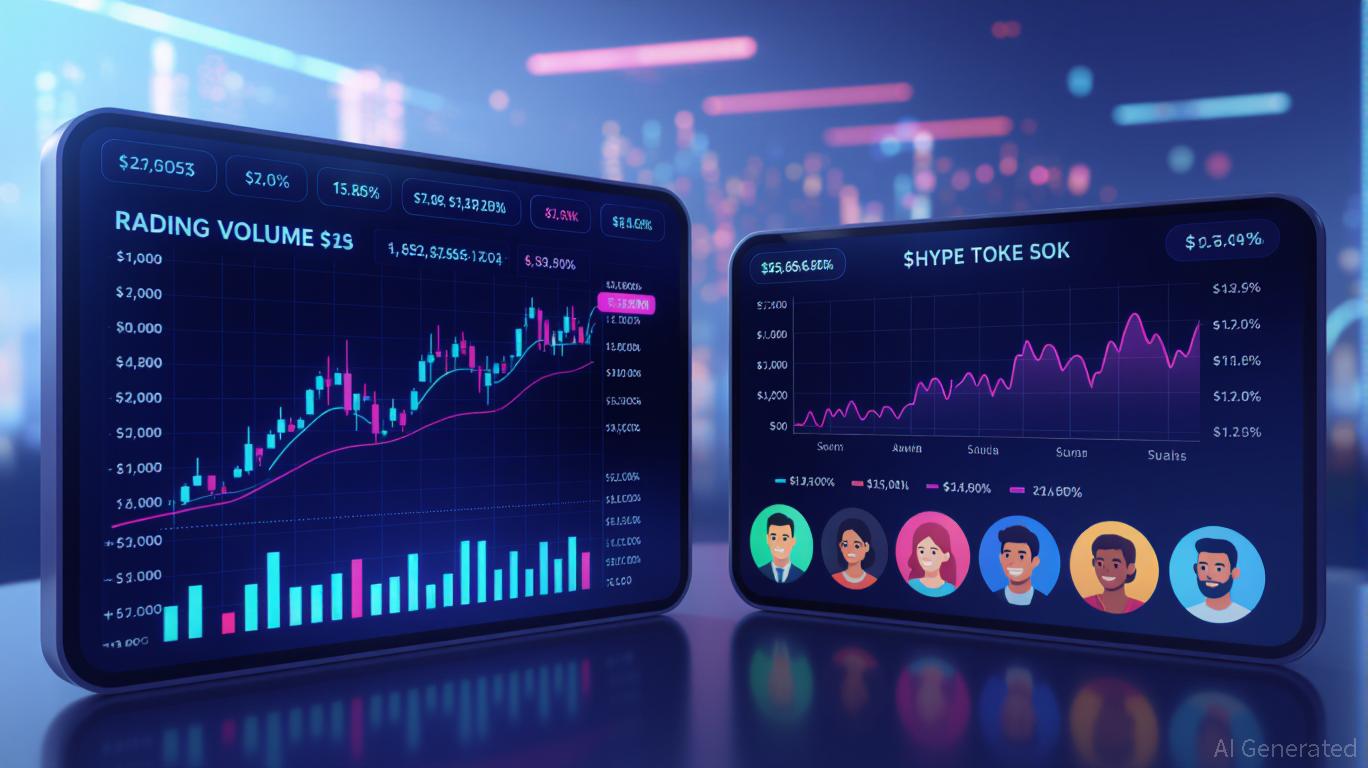Hyperliquid's Recent Rise in Attention from Retail Investors: The Impact of Retail-Fueled Liquidity on the Evolution of DeFi Trading Patterns
- Hyperliquid's retail-driven growth, fueled by token airdrops and buybacks, boosted 2025 trading volume to $320B and protocol revenue to $86.6M. - The platform's 6.1% global derivatives market share and $2.15B TVL highlight its impact on DeFi liquidity and institutional adoption. - Challenges include regulatory scrutiny and a 11.2% institutional market share decline due to tokenomics issues like a $10.8B HYPE unlock over two years.
Retail User Growth: A Catalyst for DeFi Innovation
Since its debut in 2023, Hyperliquid’s retail user numbers have soared, propelled by decentralized token allocation and incentive-based features.
The Assistance Fund, introduced in January 2025, further boosted retail participation by dedicating 97% of trading fees to buying $HYPE. This buyback approach has

Liquidity Metrics and Institutional Adoption
Hyperliquid’s liquidity statistics highlight its expanding role in DeFi. By 2025, the platform’s Total Value Locked (TVL) reached $2.15 billion,
Liquidity provided by retail users has also improved market efficiency. Hyperliquid’s adaptive funding rates, which automatically recalibrate to balance long and short positions, enhance capital utilization for traders. The platform’s integration with trusted price oracles such as
Challenges and Regulatory Considerations
Despite Hyperliquid’s remarkable growth, caution is warranted for investors. The platform’s hybrid approach—merging DeFi openness with the speed of centralized exchanges—faces regulatory scrutiny, especially under new frameworks like the EU’s Markets in Crypto-Assets (MiCA). Institutions have responded by implementing liquidity stress tests and adopting diversified strategies, including covered calls and cash-secured puts, to manage risk. Additionally, smart contract audits and multi-signature wallets are increasingly standard to address counterparty and asset security issues.
Conclusion
Hyperliquid’s rise in retail participation demonstrates how decentralized platforms can leverage user-driven liquidity to challenge conventional trading models. By aligning token economics with user rewards and utilizing advanced infrastructure, the platform has reshaped DeFi liquidity. However, continued success will depend on regulatory compliance and sustainable tokenomics.
Disclaimer: The content of this article solely reflects the author's opinion and does not represent the platform in any capacity. This article is not intended to serve as a reference for making investment decisions.
You may also like
YFI +1.21% Daily Returns from Automated Yield Agreements and DeFi Stability
- IO DeFi launches automated yield contracts to stabilize crypto returns via smart contracts, aiming to reduce manual intervention and address DeFi challenges like gas fees and slippage. - YFI rose 1.21% in 24 hours on Nov 15, 2025, but fell 6.38% in 7 days and 41.76% in a year, reflecting short-term volatility and long-term decline. - Technical analysis shows a bearish short-term trend, yet the 24-hour gain sparked optimism, highlighting market uncertainty and automated strategies’ potential to mitigate v
Bitcoin News Update: Major Whale Faces Uncertainty on $95M BTC Position Amid $327M in Crypto Liquidations Due to Market Volatility
- $327M in crypto positions liquidated, driven by longs as a whale buys 1,000 BTC ($95.3M) on Hyperliquid. - BTC volatility pushes price below $95K, exposing $5.52B in leveraged exposure with $159M in long losses. - Crypto slump sees $492M ETF outflows, 1.5% ETH drop, and 2.2% SOL decline amid AI stock concerns. - Tether invests €1B in German robotics firm Neura, expanding beyond stablecoins into AI and real-world assets. - Japan and UK introduce stablecoin regulations as macroeconomic uncertainty amplifie

Bitcoin News Today: Harvard Invests $442M in IBIT—Traditional Finance Turns to Bitcoin for Portfolio Diversification
- Harvard triples stake in BlackRock's IBIT to $442.8M, becoming top institutional holder. - Bitcoin ETFs attract $60.8B in inflows since 2024, with BlackRock's IBIT dominating the market. - Harvard's move reflects institutional shift toward crypto as inflation hedge despite volatility. - Analysts highlight Bitcoin's scarcity and regulatory clarity as key drivers for portfolio diversification. - Brown University and others may follow, signaling broader adoption of Bitcoin ETFs.
Solana News Update: Solana ETFs Attract $370 Million Despite 34% Price Drop—Institutional Optimism Defies Negative Sentiment
- Solana ETFs attracted $370M in 13 days despite 34% price drop, driven by Bitwise and Grayscale products. - Institutional inflows contrasted broader crypto outflows as technical indicators signaled bearish sentiment below $140. - NYSE launched Solana ETF options, intensifying altcoin ETF competition with VanEck's regulatory filings. - Diverging ETF demand and price weakness raised sustainability concerns amid declining retail enthusiasm.
